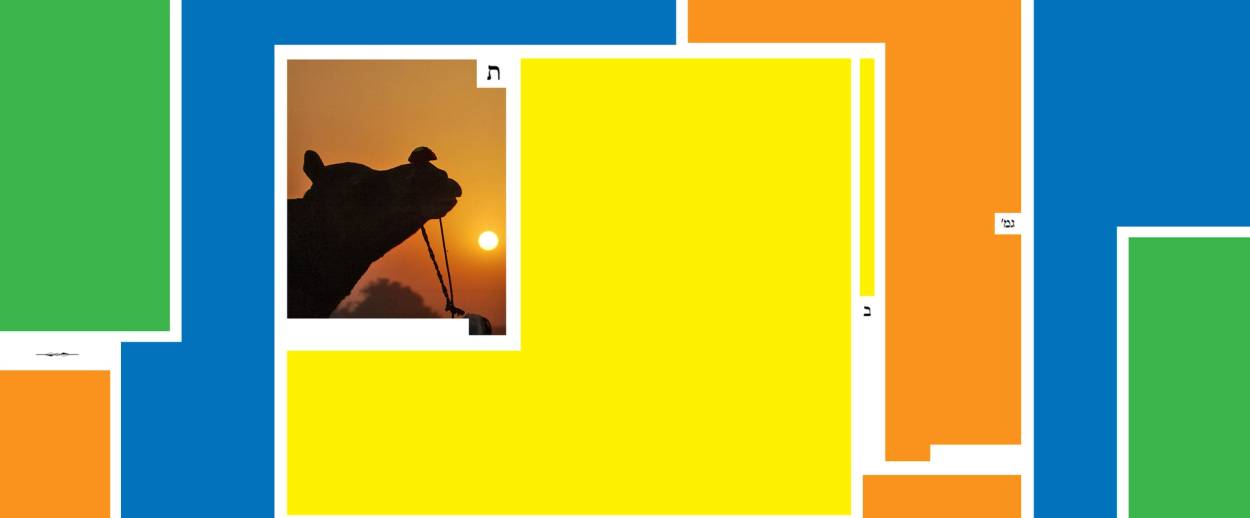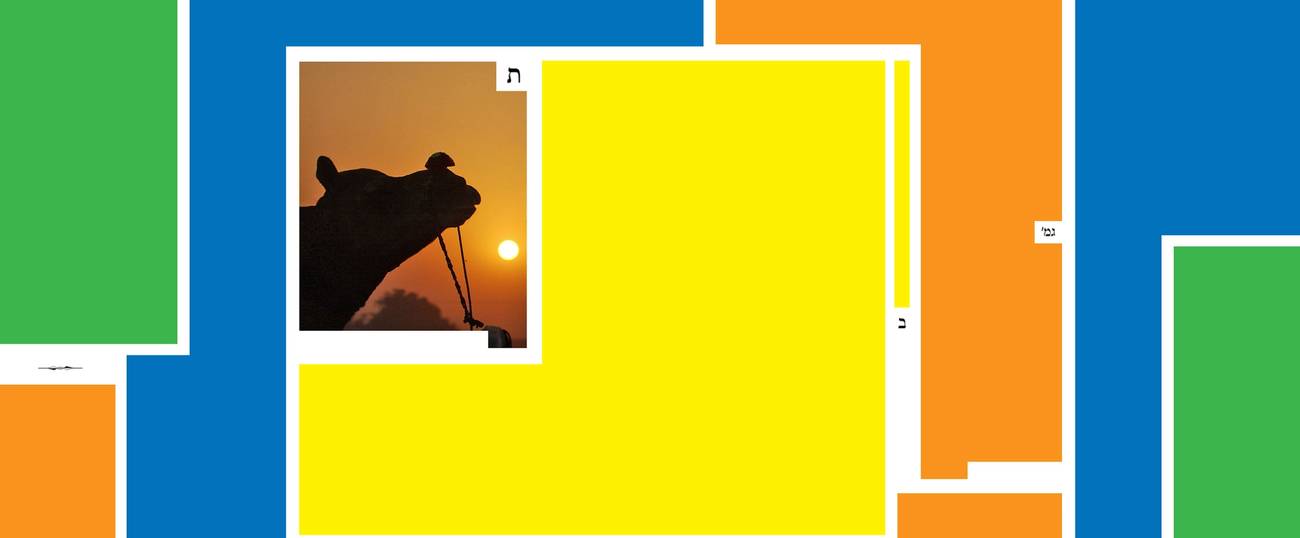The Shock of Recognition
As the ‘Daf Yomi’ cycle returns to a familiar anecdote about a camel causing a fire, it reveals the Talmud’s complex web of interlaced elements as more than a compendium of laws




Literary critic Adam Kirsch is reading a page of Talmud a day, along with Jews around the world.
One of the pleasures of reading Daf Yomi is to see how certain ideas and examples appear, disappear, and then return, sometimes much later in the Talmud. Like the themes in a symphony, the recurrence of these elements creates a sense that the Talmud is not just a collection of disparate laws—as it sometimes feels in the reading—but a giant structure, whose different parts refer to and reinforce one another. This week’s reading brought a good example of what I mean. One of the earliest things we read in the Daf Yomi cycle—way back in the fall of 2012, in Tractate Berachot—was a law concerning liability for fires related to Hanukkah menorahs. As I recall it, the law stated that if a camel is walking down the street carrying a load, and the load reaches into a window where a menorah is burning and catches fire, and the fire then spreads, the owner of the menorah is not liable for the resulting damage. The reason is that displaying a menorah in the window is a mitzvah, and one shouldn’t be discouraged by possible liability from performing a mitzvah.
I don’t know why this particular example should have stayed with me for almost four years—perhaps because it was such a vivid example of the way the Talmud conjures up ordinary life in the ancient world. But I had a shock of recognition this week, when the same example reappeared in a different context in Bava Kamma 22a. Here we read the general principle to which the menorah case was an exception: “In the case of a camel that was laden with flax and was passing through the public domain, and its flax extended into a store and caught fire from a lamp belonging to the storekeeper, and as a result the camel set fire to the building, the owner of the camel is liable for the damage. But if the storekeeper placed his lamp outside in the public domain, the storekeeper is liable.”
Here one of the Talmud’s perennial concerns—the difference between public and private domains, which plays such a central role in Shabbat law—intersects with the main subject of Bava Kamma, which is damage caused by negligence. At issue is what in American law is called “the standard of care”: How much precaution do you have to take to ensure that your lamp doesn’t cause a fire? Lighting a lamp inside your own home is presumptively safe, because it’s very unlikely that a camel carrying flax will walk through your living room and catch fire. But lighting a lamp that is hung from the front door, or displayed in an open window, is presumptively reckless, because it’s reasonable to expect that a flax-laden camel would be walking down the street. It’s only on Hanukkah that the mitzvah of displaying a menorah in the window overrides this principle.
This was just one of the many animal-related perils canvassed in this week’s Daf Yomi reading. As we saw last week at the beginning of Bava Kamma, the law of damages caused by animals falls under the category that the Talmud calls “Ox.” This is because such laws are deduced from the example laid down in Exodus of an ox that gores another animal or a person. The crucial distinction in that case is whether the ox is “innocuous”—that is, it has no history of goring, and so is presumed to be safe—or “forewarned”—that is, it has gored three times previously, so that a court has issued an official declaration that it is potentially dangerous. The owner of an innocuous ox does not have to pay for the damage it causes, but the owner of a forewarned ox is liable for all damages.
This basic, rather crude formula is subjected in the Talmud to many tests and variations. Take the question of being “innocuous.” An ox is presumptively harmless when it comes to goring, because it is unusual for an ox to go around stabbing people with its horns. But that same ox can be presumed to be dangerous when it comes to trampling, since it is totally normal for an ox to crush things underfoot while it walks. If you set your ox loose in your neighbor’s field, then, and it proceeds to trample his crops, a different standard of care should apply than in the case of goring. For trampling, an ox is considered automatically forewarned: that is, even if a court hasn’t declared it dangerous, its owner is liable for damage it causes through its predictable, customary behavior.
The mishna in Bava Kamma 17a, at the beginning of chapter 2, states this principle: “For what damage caused with the hoof is the animal deemed forewarned? It is deemed forewarned with regard to trampling objects and breaking them in the course of its walking.” (Here, as usual, I have quoted the English translation of the Koren Talmud, which usefully expands the Talmud’s curt language into full, clear sentences. But it’s useful every once in a while to remember that the actual Hebrew of the mishna is much terser than this. The above passage, translated more literally, reads: “What the hoof forewarned? Breaking in the course of its walking.” This compression is one reason why it would be so difficult to study the Talmud alone in its original languages; you would often need a teacher just to explain the basic meaning of the words. In this sense, the English translation serves a teacher for readers like me.)
An animal, then, can be expected to break things as it walks. But it is a broad principle of Jewish law that laws apply only in the case of typical actions, not of exceptional ones. On Shabbat, for instance, there are many actions that cannot be performed in their typical manner, but you can get away with them if you do them in an unusual way. With damages, too, typicality is important: An animal’s owner is fully liable only for damages it causes while walking in its typical fashion. If it causes damage in an atypical way, or at second hand, the owner is liable for only half the damages. The mishna gives the example of a chicken that hops around and breaks vessels (presumably fragile ones made of pottery). If the chicken directly breaks a vessel, its owner must pay the full cost. If, however, the chicken “was hopping in an atypical manner,” the owner pays only half.
This principle laid down in the mishna is discussed at great length in the Gemara, with regard to a variety of animal species. A donkey, for instance, typically wears a harness and carries a burden, so that if any of its appurtenances cause damage—saddle, saddlebag, halter, bell—the donkey’s owner is fully liable. A chicken typically flies short distances, so if it breaks things with its wings, the owner is again fully liable. But what happens if an animal causes damage only at second hand? What if—to use the Gemara’s examples—the chicken flaps its wings and the wind thus created knocks something over and breaks it? Or what if a donkey kicks pebbles as it walks and the pebbles break something? In these cases, the law offers a compromise, holding the owner liable for half the damage incurred.
Between the question of typical animal behavior and the question of indirect consequences, the law of damages has now opened up a wide field for hypothetical speculation, of the kind that the rabbis love so much. What happens, asks Rami bar Yehezkel in Bava Kamma 18b, if a rooster puts its head into a glass bottle and crows, and the sound of the crow shatters the glass? To figure out the liability here, we have to ask first, is it typical for a rooster to put its head in a bottle? What about if there are seeds in the bottle, and the rooster was trying to eat them—does this render the rooster’s behavior typical, since it is surely characteristic of animals to eat? And second, is a rooster’s crow part of its body, or is it a secondary force? This reminds me of the question debated in Tractate Shabbat, about whether spittle is considered an object—in which case you could not walk in the public domain with a mouthful of spit—or a part of the body. Questions about substance and essence and definition turn out to be crucial to all different areas of Jewish law—another way in which the Talmud’s unity is maintained throughout all its diversity.
***
To read Tablet’s complete archive of Daf Yomi Talmud study, click here.
Adam Kirsch is a poet and literary critic, whose books include The People and the Books: 18 Classics of Jewish Literature.